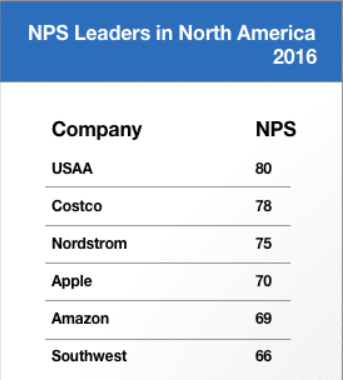
Why Net Promoter Score Is the Best Metric for Long-term Growth
It’s easy to get caught up in website traffic numbers, conversion rates, and that essential ROI of your marketing campaigns. These metrics are useful for demonstrating where you are now and the quality and effectiveness of the strategies you used to get to this point.
But, they can’t show you everything. What they’re failing to illuminate is just as important as the past and the present. They’re not revealing the future.
How likely is the brand you are promoting likely to succeed over the next few years? What about the next couple decades? What is the long-term growth outlook? You need to have a data-informed concept of where you are going in order to make the smart decisions that will lead you to a successful future.
Don’t panic. You’re not going to have to take up tarot reading to gain clear insight into business growth. What you need is NPS.
What Is Net Promoter Score?
Net Promoter Score may simply be one unassuming number between -100 and 100, based on one unassuming question:
How likely is it that you would recommend X-brand to a friend or colleague?
But within the answer to that question is an honest look at customer retention, loyalty, and potential for business growth. It is the sine qua non for measuring the customer experience.
NPS was created by Frederick Reichheld and Bain & Company almost fifteen years ago. After looking at the success of the rental car company, Enterprise, to determine growth based on their short, two-question surveys, Reichheld spent years researching what was going on to make their simple strategy so effective.
He found that the key was in using their survey questions to track the number of enthusiastic customers. Not people who were satisfied. Not those who had an okay experience but could be cajoled to come back with a promotional discount. But those who loved Enterprise’s services enough to take the next step of telling other people about how much they enjoyed their experience. These were the people who would come back and who would create lasting growth.
As Reichheld explained, “By substituting a single question for the complex black box of the typical customer satisfaction survey, companies can actually put consumer survey results to use and focus employees on the task of stimulating growth.”
Back in 2003, Bain found that between 60 and 80 percent of customers who described themselves as satisfied, don’t actually return to do more business with the brand that did originally live up to their expectations. This means, with a lot of the customer feedback channels marketers are using, they may not always be able to gauge how many customers will become repeat customers and how many they’ll never see again.
The Net Promoter Score solves this problem because it is designed to reveal how well a brand is at creating an experience that leads to enthusiastic customers. That number is the essential indicator of business growth.
How NPS Works
To determine the NPS, customers are asked the golden question listed above about the likeliness of recommending a particular brand to others. They are asked to rate their level of motivation on a scale of 0 to 10.

Then, based on the score they choose, each respondent is grouped into one of three categories.
1. Detractors rate their likeliness to recommend between 0 and 6. They’re assumed to be unsatisfied and may, therefore, be motivated to speak negatively about your products or services. The percentage of detractors is what drags the NPS down. A large percentage can be an obstacle to growth, has the power to slow business, and could indicate a negative brand reputation you may not be otherwise aware of. With an army of detractors, both marketing and sales are going to have to do some serious brand repair and customer experience management work to turn things around.
2. Passives rate their likeliness to recommend as either a 7 or 8. They were satisfied with their experience but probably not enough to come back or to write a positive review on Yelp. Passives aren’t included in the Net Promoter Score calculation.
3. Promoters rate their likeliness to recommend as either a 9 or 10. These are the blue-chip customers, the ones you should be sending out edible fruit baskets to. They’re probably going to keep buying or subscribing. Even more important, they’re likely to tell their friends about how great your product or service is. Word-of-mouth advertising is the most credible type of advertising among consumers, according to Nielsen’s 2015 Global Trust and Advertising Survey.
This is why the NPS is so elegantly revealing. If you don’t have a lot of Promotors – 20 to 30 percent for example – yet half of respondents chose a mediocre 4 to 6, your NPS is still going to be negative. What this metric points out is how critical it is for marketers to strive for an extremely satisfying customer experience, not just an ‘okay, that was fine.’ It also encourages work on the bottom. What steps can a business take to end up with as few Detractors as possible? How can you prevent dissatisfaction?
What’s a Good NPS?
When Fred Reichheld looked at 400 companies across 18 different industries, he found the median NPS was 16. This is a strikingly low number. You certainly want to shoot for the sky with your NPS. To look at a general benchmark:
- Anything below 0 indicates a problem with the customer experience
- Above 50 is considered excellent
- 70 and up and your brand is capable of delivering a world-class customer experience.
Having a world-class NPS isn’t just a bragging right. It is going to create organic growth. This is part of Reichheld’s premise on why the Net Promoter Score is so powerful. Those Promoters become a built-in, highly effective part of your marketing strategy. To give you an idea of the successful mega-brands in the US who have a strong NPS, here are 2016’s top brands:

If you take steps to inspire more Promoters by optimizing the customer experience, continually improving products/services, and focusing on customer relationship building, then you allow the magic to happen. They talk about the product to co-workers. Share it on social media. Use it in front of their friends. Introduce it to their families.
Your Promoters promote your brand – without even realizing what they’re doing. Once you get to this point, part of your business growth becomes effortless.
Hone in on your NPS. If you can get that metric up, you are taking a powerful step in the direction of sustainable long term growth.







Thanks Michael! We’re using this for CMWorld now and it’s a great way for us to look at our attendees and customers. I shared this with the CMI team too!
What a great idea Cathy to use it for events! Thanks so much and talk soon!